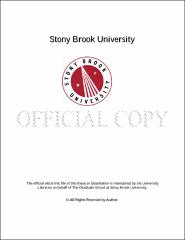| dc.identifier.uri | http://hdl.handle.net/11401/76698 | |
| dc.description.sponsorship | This work is sponsored by the Stony Brook University Graduate School in compliance with the requirements for completion of degree. | en_US |
| dc.format | Monograph | |
| dc.format.medium | Electronic Resource | en_US |
| dc.language.iso | en_US | |
| dc.publisher | The Graduate School, Stony Brook University: Stony Brook, NY. | |
| dc.type | Dissertation | |
| dcterms.abstract | In order to provide a new coordinate-space perspective applicable to scattering amplitudes, in the first part of this dissertation, the structure of singularities in perturbative massless gauge theories is investigated in coordinate space. The pinch singularities in coordinate-space integrals occur at configurations of vertices which have a direct interpretation in terms of physical scattering of particles in real space-time in the same way as for the loop momenta in the case of momentum-space singularities. In the analysis of vertex functions in coordinate space, the well-known factorization into hard, soft, and jet functions is found. By power-counting arguments, it is found that coordinate-space integrals of vertex functions have logarithmic divergences at worst. The `hard-collinear' and `soft-collinear' approximations that allow the application of gauge theory Ward identities in the formal proof of factorization in coordinate space are introduced. In the second part, the perturbative cusp and closed polygons of Wilson lines for massless gauge theories are analyzed in coordinate space, and expressed as exponentials of two-dimensional integrals. These integrals have geometric interpretations, which link renormalization scales with invariant distances. A direct perturbative prescription for the logarithm of the cusp and related cross sections treated in eikonal approximation is provided by web diagrams. The sources of their ultraviolet poles in coordinate space associated with their nonlocal collinear divergences are identified by the power-counting technique explained in the first part. In the study of the coordinate-space matrix elements that correspond to scattering amplitudes involving partons and Wilson lines in coordinate space, a series of subtractions is developed to eliminate their divergences and to show their factorization in coordinate space. The ultraviolet finiteness of the web integrand is shown by relating the web expansion to the application of this additive regularization procedure to the massless cusp. Generalizations for multieikonal and partonic amplitudes are discussed, and the factorization of these coordinate-space amplitudes into hard, jet and soft functions is verified. | |
| dcterms.available | 2017-09-20T16:51:01Z | |
| dcterms.contributor | Sterman, George | en_US |
| dcterms.contributor | van Nieuwenhuizen, Peter | en_US |
| dcterms.contributor | Goldhaber, Alfred | en_US |
| dcterms.contributor | Metcalf, Harold | en_US |
| dcterms.contributor | Kilgore, William. | en_US |
| dcterms.creator | Erdogan, Ahmet Ozan | |
| dcterms.dateAccepted | 2017-09-20T16:51:01Z | |
| dcterms.dateSubmitted | 2017-09-20T16:51:01Z | |
| dcterms.description | Department of Physics. | en_US |
| dcterms.extent | 146 pg. | en_US |
| dcterms.format | Application/PDF | en_US |
| dcterms.format | Monograph | |
| dcterms.identifier | http://hdl.handle.net/11401/76698 | |
| dcterms.issued | 2014-12-01 | |
| dcterms.language | en_US | |
| dcterms.provenance | Made available in DSpace on 2017-09-20T16:51:01Z (GMT). No. of bitstreams: 1
Erdogan_grad.sunysb_0771E_12001.pdf: 2158475 bytes, checksum: f3f82cd6e26251999e32adaa8ddfc66d (MD5)
Previous issue date: 1 | en |
| dcterms.publisher | The Graduate School, Stony Brook University: Stony Brook, NY. | |
| dcterms.subject | Physics | |
| dcterms.title | Quantum Field Theory in Coordinate Space | |
| dcterms.type | Dissertation | |

